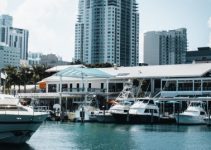Best Places to Live in Miami
Contents
Even though I never planned to live here, I love living in Miami. I can drive in any direction in the city and find amazing sights.
When my spouse said his company was moving us to Miami, I was shocked. I knew nothing about Florida or about Miami. But after I became acquainted with the city, I realized it is truly as magical as it is so often called. Each area of greater Miami has its own ambiance, beautiful views, and charming features. Even the history of the city is young but fascinating. When guests arrive, I delight in driving them around the city in every direction to my favorite destinations.
Coral Gables
South of Miami, I drive into Coral Gables, a town of about 43,000, now surrounded by greater Miami. Here I drive by the historic and impressive Biltmore Hotel, built in 1926. I may even take guests inside for a glimpse of the imposing restored structure while telling about the hotel’s unusual history.
The city also has a favorite showplace, Fairchild Tropical Garden. To get there, I drive down one of the town’s many streets of overhanging foliage and answer the perennial question, “Oh, those are banyan trees.” In the 83 acre (34 ha) garden, I suggest a ride in the Garden’s tram, complete with a knowledgeable volunteer guide able to identify plants from all over the world brought in by the botanist David Fairchild.
Coral Gables also has the Village of Merrick Park, the upscale shopping destination, named for the founder of the town, George Merrick. Here I enjoy pointing out some of the historic symbolism among the trendy shops and restaurants. For instance, walking from the parking garage to the shops, we see a wall decorated with a peacock feather mosaic. Also, on the ground level overlooking the park-like seating area, we see two life-size bronze peacocks. I tell visitors that the peacocks are references to Merrick’s wife, the former Eunice Peacock, a fashion figure in her own right. I also point out the tall grasses edging dry streams that weave through walkways. The grasses allude to the nearby Everglades, a trip for another day.
Because Coral Gables is a university town, visitors usually ask to see the University of Miami. The school is alive with sports, drama, concerts, a movie theater, and classes for both young and old.
To the East
Driving east brings us to Coconut Grove, located along Biscayne Bay. For my friends who enjoy boating, I point out yacht clubs, marinas, sailing schools, and other waterfront pleasures.
For a real look at old Miami, I take visitors strolling up the path to The Barnacle, Miami’s oldest home in its original setting, now a state park. Here it is easy to imagine what life must have been like 100 years ago when Ralph Munroe came from New York to Miami and built his family’s home overlooking the Bay.
Key Biscayne
If I want to wow visitors after picking them up at the airport, I drive them over the Rickenbacker Causeway to Key Biscayne, a barrier island east of the mainland. Crossing the Causeway, visitors gasp with delight at visions of sparkling water, distant skyscrapers, cruise ships, and smaller pleasure boats skimming through the water.
The island has two family beaches, complete with trees and picnic tables before the sandy shores appear. The two-mile-long Crandon Beach with its calm water and white sand has been named among the top ten beaches in the nation. The other beach is Bill Baggs State Park with its picturesque lighthouse, two casual restaurants, recreational bicycles, and nature trail.
South Beach
Of course, the big draw of Miami is South Beach. Because of its depiction in movies and from the words of celebrities, everyone has heard of it. “But where is South Beach?” friends on a first-time visit ask. I tell them that South Beach is the southern tip of Miami Beach, a long, skinny island east of Miami with its own ambiance. In fact, when I go to Miami Beach, I feel like I’m on vacation…and I’m only twenty minutes away.
A must-do in South Beach is walking Ocean Drive. Visitors are charmed by the Art Deco facades of buildings along the street, best viewed from the beachside, along with the sizzle of the entire location. Sunbathers and wave watchers save enough time to access the white sands and dive into the warm ocean water.
Into the City
Driving down Calle Ocho or Eighth Street into the city itself, I take my guests into a different world. Spanish and English are spoken in various places in Miami, but here Spanish is the standard. We can eat in Cuban, Nicaraguan, Salvadoran, Mexican, or other ethnic restaurants whose owners come from Spanish speaking countries. In several small stores along the street, we see cigars being rolled and sold.
If I want my guests to feel they are in Spain, I take them for a meal in a well-known Spanish restaurant. Here we even hear serenading tunas, university students earning their tuition by spreading traditional Spanish melodies among customer tables.
Further down Calle Ocho, I entertain guests with a stop at a restaurant known for its traditional flamenco dance performances. Another evening after reaching downtown Miami, I surprise guests with shows presented at the magnificent Gusman Theater, built in 1926, restored in 2002, and today offering films, dances, and concerts.
Turning and driving along Biscayne Avenue next to Biscayne Bay, I point out the impressive Adriana Arsht Center, the venue for both fine arts, such as symphonies, opera, and ballet; and fun arts, such as various other performances. Further along the street, I identify a mammoth building known for a different kind of entertainment. The American Airlines Arena is where the Miami Heat basketball team plays. After the season ends, the big attractions there are rock concerts.
Back Home
After visitors take my tours around Miami, they cannot stop talking about their experiences. I tell them I wouldn’t live anywhere else. Miami may have hot weather in the summer, hurricanes in the fall, but the winters are perfect. I have to remind myself, “I live here.”







